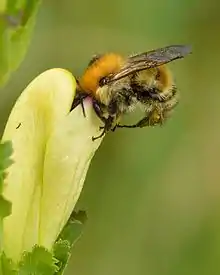Pedicularis
Pedicularis is a genus of perennial green root parasite plants currently placed in the family Orobanchaceae (the genus previously having been placed in Scrophulariaceae sensu lato[1]).




| Pedicularis | |
|---|---|
 | |
| Pedicularis bracteosa | |
| Scientific classification | |
| Kingdom: | Plantae |
| Clade: | Tracheophytes |
| Clade: | Angiosperms |
| Clade: | Eudicots |
| Clade: | Asterids |
| Order: | Lamiales |
| Family: | Orobanchaceae |
| Tribe: | Pedicularideae |
| Genus: | Pedicularis L. |
| Species | |
|
500+, see text | |
Description
Between 350 and 600 species are accepted by different authorities, mostly from the wetter northern temperate zones, as well as from South America. The highest diversity is in eastern Asia, with 352 species accepted in China alone.[2][3]
Taxonomy
The common name lousewort, applied to several species, derives from an old belief that these plants, when ingested, were responsible for lice infestations in livestock.[4][5] The genus name Pedicularis is from the Latin pediculus meaning louse.[6]
Selected species
- Pedicularis acaulis
- Pedicularis amoena
- Pedicularis arguteserrata
- Pedicularis ascendens
- Pedicularis asparagoides
- Pedicularis asplenifolia
- Pedicularis attollens (little elephant's head)
- Pedicularis baumgartenii
- Pedicularis bhutanomuscoides
- Pedicularis brachyodonta
- Pedicularis bracteosa (fern-leaf, towering, or bracted lousewort)
- Pedicularis cacuminidenta
- Pedicularis canadensis (Canadian lousewort)
- Pedicularis centranthera
- Pedicularis comosa
- Pedicularis compacta
- Pedicularis contorta (coiled lousewort or white-coiled beak lousewort)
- Pedicularis dasyantha (woolly lousewort)
- Pedicularis dasystachys
- Pedicularis densiflora (Indian warrior)
- Pedicularis dhurensis
- Pedicularis dudleyi (Dudley's lousewort)[7]
- Pedicularis elegans
- Pedicularis elephantiflora
- Pedicularis elongata
- Pedicularis exaltata
- Pedicularis ferdinandi
- Pedicularis flammea (redrattle)
- Pedicularis foliosa (leafy lousewort)
- Pedicularis furbishiae (Furbish's lousewort)
- Pedicularis friderici-augusti
- Pedicularis graeca
- Pedicularis groenlandica (elephant's head)
- Pedicularis gyroflexa
- Pedicularis hacquetii
- Pedicularis heterodonta
- Pedicularis hirsuta (hairy lousewort)
- Pedicularis howellii (Howell's lousewort)
- Pedicularis julica
- Pedicularis kaufmannii
- Pedicularis kerneri
- Pedicularis labradorica
- Pedicularis lanata
- Pedicularis lanceolata
- Pedicularis langsdorfii
- Pedicularis lapponica (Lapland lousewort)
- Pedicularis leucodon
- Pedicularis limnogena
- Pedicularis mixta
- Pedicularis oederi (crimson-tipped lousewort)
- Pedicularis ornithorhyncha (duck's-bill/bird's-beak lousewort)
- Pedicularis orthantha
- Pedicularis oxycarpa
- Pedicularis palustris (marsh lousewort)
- Pedicularis parryi (Parry's lousewort)
- Pedicularis pectinata
- Pedicularis petiolaris
- Pedicularis physocalyx
- Pedicularis portenschlagii
- Pedicularis procera (giant lousewort)
- Pedicularis pyrenaica
- Pedicularis racemosa (sickle-top lousewort, parrot's beak)
- Pedicularis rainierensis (Mount Rainier lousewort)
- Pedicularis recutita
- Pedicularis resupinata
- Pedicularis rex
- Pedicularis rosea
- Pedicularis rostratocapitata
- Pedicularis rostratospicata
- Pedicularis sceptrum-carolinum (Moor-king lousewort)
- Pedicularis schizocalyx
- Pedicularis semibarbata (pinewoods lousewort)
- Pedicularis sibthorpii
- Pedicularis sudetica (fernweed, Sudeten lousewort or Sedetic lousewort)
- Pedicularis sylvatica (common lousewort)
- Pedicularis tuberosa
- Pedicularis uralensis
- Pedicularis verticillata (verticillate lousewort)
Pollination
Bombus polaris has an essential role in the pollination of the large zygomorphic flowers of Pedicularis.[8] B. polaris has a special adaption that allows it to work the spikes of Pedicularis from the bottom towards the top.[8]
References
- IPNI (Pedicularis assigned to Scrophulariaceae)
- Species accepted by the Flora of China (not detailed here; see external links for details).
- O'Neill, A. R.; Rana, S. K. (2019). "An ethnobotanical analysis of parasitic plants (Parijibi) in the Nepal Himalaya". Journal of Ethnobiology and Ethnomedicine. 12 (14). doi:10.1186/s13002-016-0086-y.
- Jepson Manual Treatment: Pedicularis
- "Online Virtual Flora of Wisconsin - Pedicularis canadensis". wisflora.herbarium.wisc.edu. Retrieved 19 June 2020.
- Horn, compiled and edited by Dennis Horn and Tavia Cathcart ; technical editor, Thomas E. Hemmerly ; photo editors, David Duhl and Dennis (2005). Wildflowers of Tennessee, the Ohio Valley, and the Southern Appalachians: the official field guide of the Tennessee Native Plant Society. [Edmonton]: Lone Pine Pub. p. 288. ISBN 978-1-55105-428-5.
- The Status of Rare, Threatened, and Endangered Animals and Plants of California (PDF), California Department of Fish and Game, Rare Plant Program, 2000, p. 181, retrieved 2007-11-16
- Kevan, Peter G. (1972-11-01). "Insect Pollination of High Arctic Flowers". Journal of Ecology. 60 (3): 831–847. doi:10.2307/2258569. JSTOR 2258569.
| Wikimedia Commons has media related to Pedicularis. |